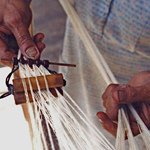
Art History/Craft History, Craft, Handloom, Art
Threads of Continuity
Lilaowala, Ashdeen Z.
August, 2012
The Sudreh and Kusti have become universal symbols of the Zoroastrian faith. While there are no written records of when the kusti originated and it is not certain of who wove or wore the first kusti, it is obviously a part of the Indo-Aryan Sacred tradition. It is seen in the Janoi of the Hindu tradition and even in the cord worn over priestly garments in the Orthodox Church.
The Avestan word for the sacred thread is “aiwyaonghana,” meaning to gird around, it originates from the Yasna ceremony where a strip of the date palm is used to tie the Barsam twigs, in a ritual of uniting creation. The Yasna like the Yagna is a Bronze Age Aryan ritual which nurtures creation and as the priest recites the Yatha Hu Vairyo Manthra, whenever he utters the word Shyaothnanam, “to act” or “of action”, he ties the date palm cord into a reef knot. This is the exact reef knot which is tied at the word Shyaothnanam in the kusti ritual. So the girding of the kusti becomes symbolic of the Zoroastrian girding himself each morning in sacred armour, the Sudreh and kusti, to become a warrior defending Spenta or Holy Creation.
Some legends state that Zarathustra initiated the kusti ritual, but according to the Dadestan-i-Denig and the Sad Dar, Chapter X i-xv, these symbols have been worn since the time of King Jamshed. Wearing the kusti is like performing “Hama Zor” and “Hama Asho”, uniting to perform good works and remainin...
PRACTITIONERS: INDIA
Access 70,000+ practitioners in 2500+ crafts across India.
BIBLIOGRAPHY
10,000+ listings on arts, crafts, design, heritage, culture etc.
GLOSSARY
Rich and often unfamiliar vocabulary of crafts and textiles.
SHOP at India InCH
Needs to be written.






